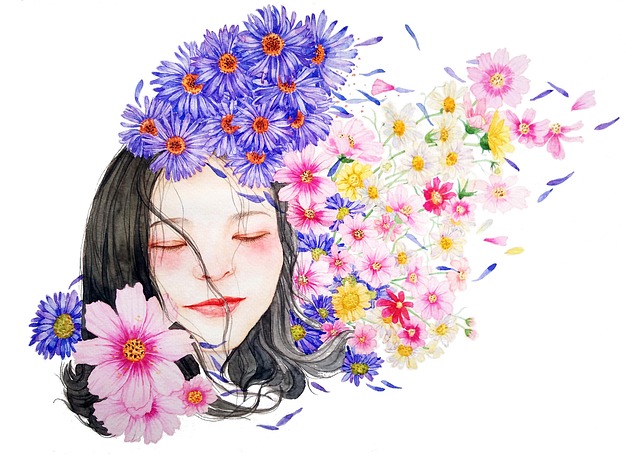
For the longest time I was unclear about the term “muse.” What did it mean to have a muse and did I have one? I felt as a writer, that I should know this instinctively, but I didn’t and it seemed an embarrassing question to ask. So I did some research and reading and here is what I found.
The trail of the muse leads back to Greek mythology. Residing in Olympus were nine sisters, The Muses, daughters of the god Zeus and Mnemosyne (Memory). Much of what we know about The Muses comes from the early Greek poet, Hesiod, who wrote an account of the creation of the universe and the generations of the gods. Hesiod said of The Muses:
They are all of one mind, their hearts are set upon song and their spirit is free from care. He is happy whom The Muses love; sweet flow speech from his mouth.
The Muses had the power to alleviate a man’s sorrow and heaviness of spirit by granting him the gift of words. Hesiod paints a picture of The Muses as a source of inspiration and a source of healing, able to remove blocks to writing. So from the beginning there is a suggestion that something supernatural, something magical, occurs in the presence of The Muses.
There is a chapter in Natalie Goldberg’s book, The True Secret of Writing, called “The Altar.” In that chapter, she talks about the Mabel Dodge Luhan House, in Taos, New Mexico, where she holds writer retreats. One shelf in the meditation practice room, is dedicated to the names of the dead that she and the retreat participants want to remember. On another shelf, are photos of people considered muses, those “whom we write for.” These pictures are of loved ones, pets, favourite authors, places. And other things get placed their too- “feathers, bones, stones, small green hard pears in August and plums in late spring.”
Goldberg’s words, “those whom we write for,” indicates that we can take control of the muse/writer relationship. We don’t have to sit and wait for inspiration or healing, we can find that spark we need by writing from a sense of honour and commemoration towards the people, animals, places or things which mean the most to us. Goldberg suggests making this relationship more concrete by setting up a small altar somewhere in your home. So I did.
On the corner of my desk I have collected a series of photos -my paternal grandparents wedding portrait, my Dad and I on my first birthday, my late cat Bluey, the Lodge- and a piece of grandpa’s pottery, a feather, two handmade ceramic birds and a bookmark from my Dad’s now defunct, bookstore. Each object or picture invokes a feeling- praise, grief, acceptance, forgiveness, joy. They are touchstones that help me get to that place of truth inside myself. The place where the best writing comes from.
In her latest book of poems, The Analyst, Molly Peacock explores the idea of psychoanalysis as a means of creative release. At a recent reading at the Toronto Poetry Circle, that she dubbed, “The Muse Talks Back,” Peacock revealed that after more than 20 years of therapy, she’s learned that “living the examined life doesn’t destroy your art.”
It’s okay to reach back and poke around in the territory of memories. The act of remembering is a valuable writer’s tool.
Sometimes there is a magical element to the writing process- those times when words seem to come without effort and flow like a river onto the page-but often that magic can be traced back to the behind- the -scenes work an author has done; questioning and examining day to day and past experiences.
But probing in our memory pools can bring difficult emotions to the surface; emotions that have the capacity to freeze our writing instead of freeing it. This is where our muse- the person or thing we are writing for- steps in to alleviate our distress. Hesiod describes it this way in his poem, “Theogony” :
For though a man has sorrow and grief in his soul, yet when the servant of the muses sings, at once he forgets his dark thoughts and remembers not his troubles. Such is the holy gift of the muses to men.
Not that it is easy to dispel sorrow, but as Edward Hirsch says in his book, Poet’s Choice, in the chapter on fellow poet Jane Mayhall’s memorial poems for her late husband:
The only anodyne[for intense grief] is ardent creative work, the solace of making art, of defying time.
That is what our muse(s) can bestow on us; the inspiration to write even when life seems too much to bear. And in the act of writing, we release creative energy which becomes a force of additional inspiration. The more you write, the more you can, and the more you want, to write.
The nature of the muse seems clear to me now, and I realize that it is possible to cultivate a connection to the muse. As writers, each of us can do that if we spend some time thinking about whom or what we are writing for.
Try this: make an altar to your muse by placing a photo(s) and/or a few precious objects in a prominent place in your home. Allow the emotions that arise from this remembrance, to fuel your writing. Be gentle with yourself if uncomfortable feelings arise, and have faith that what will come from this muse connection will be healing and it will be the truth.
Hesiod wrote that one day The Muses appeared to him and said:
We know how to speak false things that seem true, but we know, when we will, to utter true things.
Til next time, keep writing.
